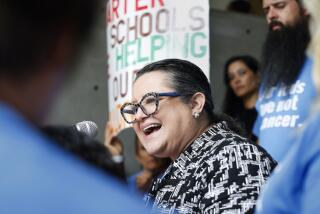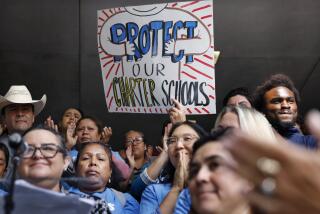For two L.A. schools, sharing a campus is starting to chafe
Three years ago, Logan Street Elementary looked like the perfect spot for high-performing, growing Gabriella Charter School. Logan, a low-performing neighborhood school with declining enrollment, had room to spare.
But Logan has begun to rebound, opening up a language program with teaching in both Spanish and English and adding middle-school grades. And its test scores have risen.
Now the Echo Park campus is becoming too small for two burgeoning operations: an improving traditional school and an exemplary charter. Neither intends to surrender its hold on the campus.
The situation exemplifies issues that arise when schools must share campuses. Across the Los Angeles Unified School District, 58 charters operate alongside neighborhood schools. Charters have fit in comfortably on new campuses, such as Synergy Kinetic Academy at the Nava Learning Center in South Los Angeles. There are more logistical hurdles and resistance at older schools.
The California Charter Schools Assn. is battling L.A. Unified in court over access to campuses. For many charters, which are publicly funded and independently operated, locating and paying for real estate is a persistent challenge. Charters argue that the district should provide more classrooms, given that L.A. Unified has declining enrollment and about 1 in 8 of its students attend charters.
Under state law, charters have a right to district facilities that are “reasonably equivalent” to regular district schools’. But these arrangements cover only one year at a time; charters risk having to change locations frequently.
The Gabriella deal was an attempt to prevent such a disruption. L.A. Unified agreed to let Gabriella, which operated about two miles away near MacArthur Park, move to Logan starting in the 2009-10 school year. The district this month renewed Gabriella’s charter for five years, which, under the deal, automatically included letting it stay at Logan. The renewal never was in doubt — Gabriella has some of the highest test scores in the state, with an enrollment that is 90% low-income, minority students.
L.A. Unified also spent $2 million in voter-approved construction bonds to convert a portion of a Logan classroom building into two fully outfitted dance studios that opened in 2010. The charter’s most distinctive feature is a comprehensive, daily dance program for all students. After school, the studios are used by a community dance program, run by Gabriella’s founders, that is offered for $7 a month.
The studios are emblematic of the uneasy coexistence. They are the major recent upgrade to the well-worn campus and off limits to Logan students during the school day. A handful take dance after school, but the program serves a broad area, and vacancies are filled by lottery.
Only Logan uses the cafeteria for meals. Gabriella students eat outside at tables — or in classrooms when it rains.
The asphalt playground is split by orange cones, which are shifted to allow each school rotating access to different play areas.
Logan’s expansion through eighth grade has added complications. Given the smaller, divided playground, Logan doesn’t let its middle-schoolers use the playground during their morning break and lunch. And one day a week, eighth-graders remain in classrooms for physical education because Gabriella has the entire playground at that time.
Gabriella forbids its students from using the playground before school, dissatisfied with the level of supervision.
The charter school, which also runs through eighth grade, has stretched beyond its original bungalows into two other buildings.
When needed classroom space wasn’t forthcoming last year, Gabriella converted its office into a classroom and occupied the auditorium as an ad hoc office and storage space. L.A. Unified officials ordered them out — but quickly provided the needed classroom.
Logan’s low point in enrollment was two years ago, when it had 475 students. It’s now up to 550. Gabriella has 436. The campus is now as packed as it was in 2000, when Logan was considered overcrowded.
Logan supporters insist it’s unfair for Gabriella students to crowd their campus when about two-thirds live outside the attendance area; Gabriella insists that about two-thirds come from “greater Echo Park.” Anyone can apply; admission is by lottery when oversubscribed.
Some of the resistance to Gabriella is born of the area’s traditionally liberal, pro-union roots; activists have opposed all charter schools in the neighborhood, at least partly because most are non-union.
There’s also resentment over Gabriella providing smaller classes and more frequent maintenance.
The campus lacks science labs for the middle school students, not to mention a gym, a functioning library and a playground with green space.
“I think all the students at both schools are getting hurt,” said Tad Yenawine, a parent on Logan’s leadership council. “It’s pretty clear a solution needs to be found. The only way this really works is that Gabriella moves.”
Gabriella administrators said they intend to make do as things are.
“Being charter people, we’re used to being creative with space,” Principal Lisa Rooney said. “We can make it work with what we have.”
Mollie Jones, a Gabriella parent, agreed.
“We have different buildings and entrances,” she said. “The layout is a little random, but the focus here is on learning. The fact that we share the campus with another school is probably the least interesting thing about the school.”
More to Read
Start your day right
Sign up for Essential California for news, features and recommendations from the L.A. Times and beyond in your inbox six days a week.
You may occasionally receive promotional content from the Los Angeles Times.






